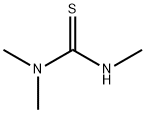Trimethylthiourea is a thiourea derivative. Patients
sensitized to ethylbutyl thiourea ean also react to
trimethylthiourea.
1,1,3-Trimethylthiourea can be used to synthesize many isothiouronium compounds.
Prisms (from benzene or ligroin) or off-white powder.
Very slightly soluble in water.
An organosulfide amide. Organosulfides are incompatible with acids, diazo and azo compounds, halocarbons, isocyanates, aldehydes, alkali metals, nitrides, hydrides, and other strong reducing agents. Reactions with these materials generate heat and in many cases hydrogen gas. Many of these compounds may liberate hydrogen sulfide upon decomposition or reaction with an acid. Organic amides/imides react with azo and diazo compounds to generate toxic gases. Flammable gases are formed by the reaction of organic amides/imides with strong reducing agents. Amides are very weak bases (weaker than water). Imides are less basic yet and in fact react with strong bases to form salts. That is, they can react as acids. Mixing amides with dehydrating agents such as P2O5 or SOCl2 generates the corresponding nitrile. The combustion of these compounds generates mixed oxides of nitrogen (NOx).
ACUTE/CHRONIC HAZARDS: When heated to decomposition TRIMETHYLTHIOUREA emits toxic fumes of nitrogen oxides and sulfur oxides.
Flash point data for TRIMETHYLTHIOUREA are not available; however, TRIMETHYLTHIOUREA is probably combustible.
Trimethylthiourea is a thiourea derivative used, for
example, for polychloroprene (neoprene) rubber vul-
canization. Patients sensitized to ethylbutyl thiourea
can also react to trimethylthiourea.
Poison by ingestion.
Questionable carcinogen with experimental
carcinogenic data. Mutation data reported.
When heated to decomposition it emits very
toxic fumes of NOx and SOx. See also
ISOTHIOUREA.
